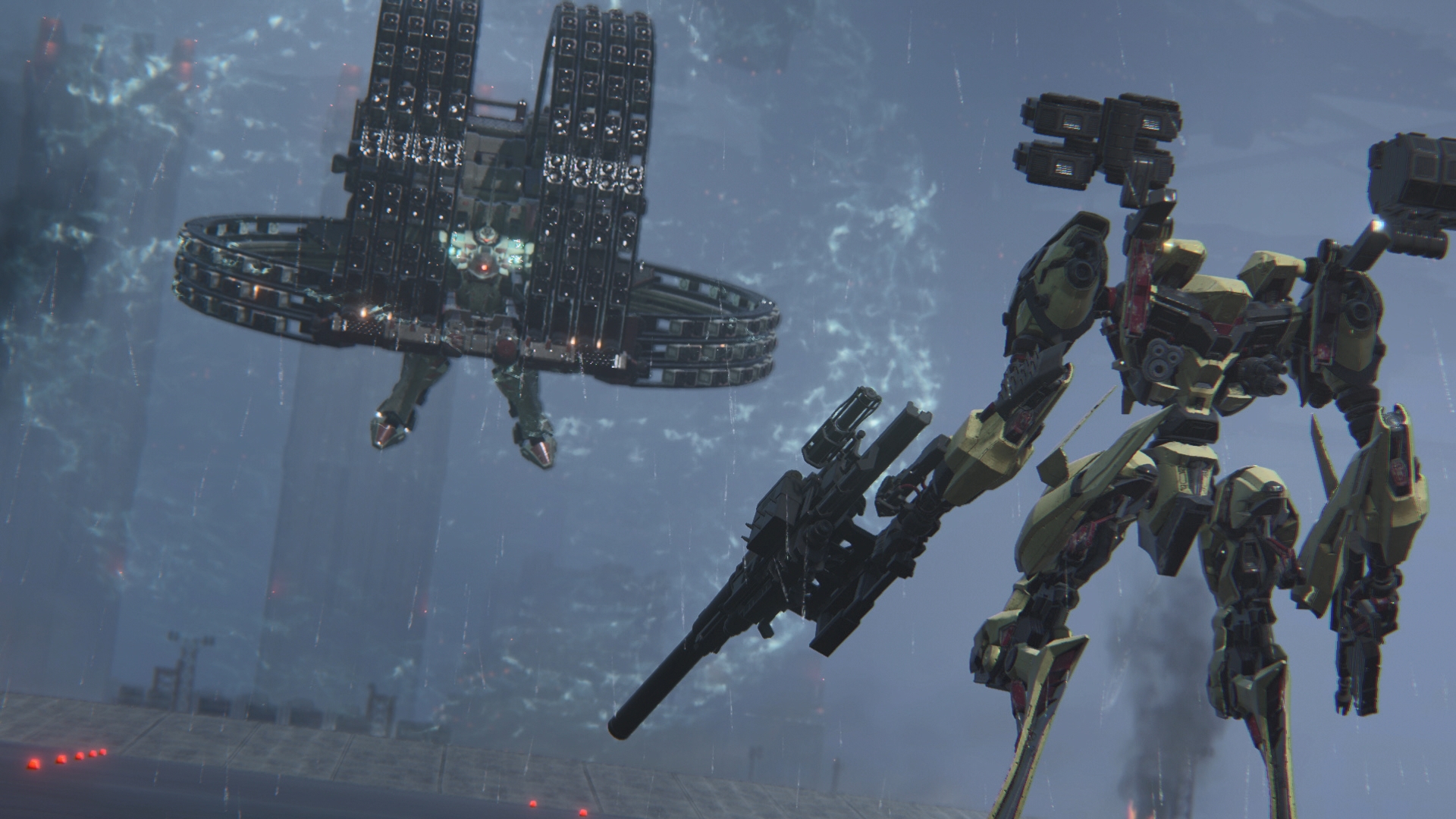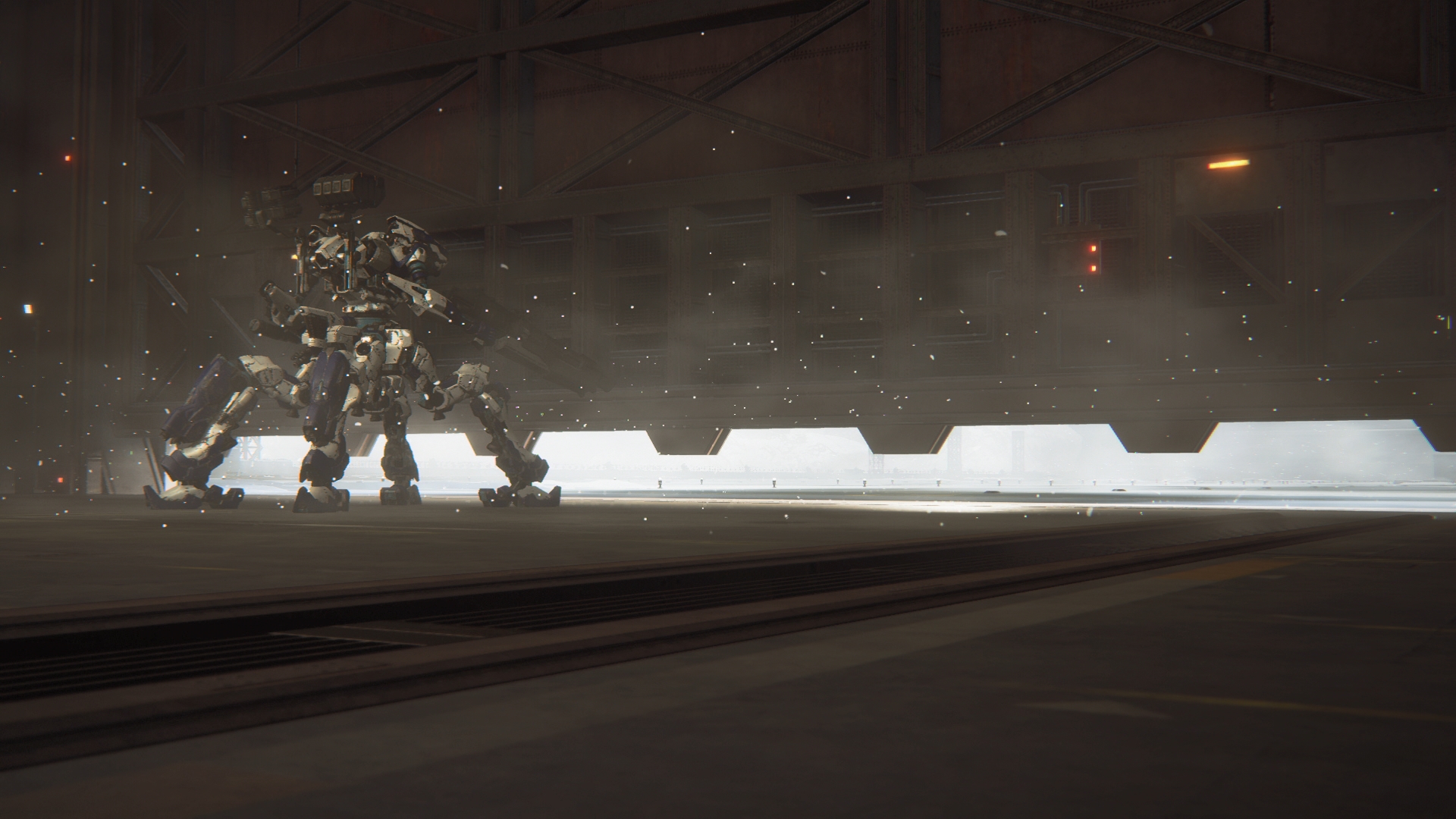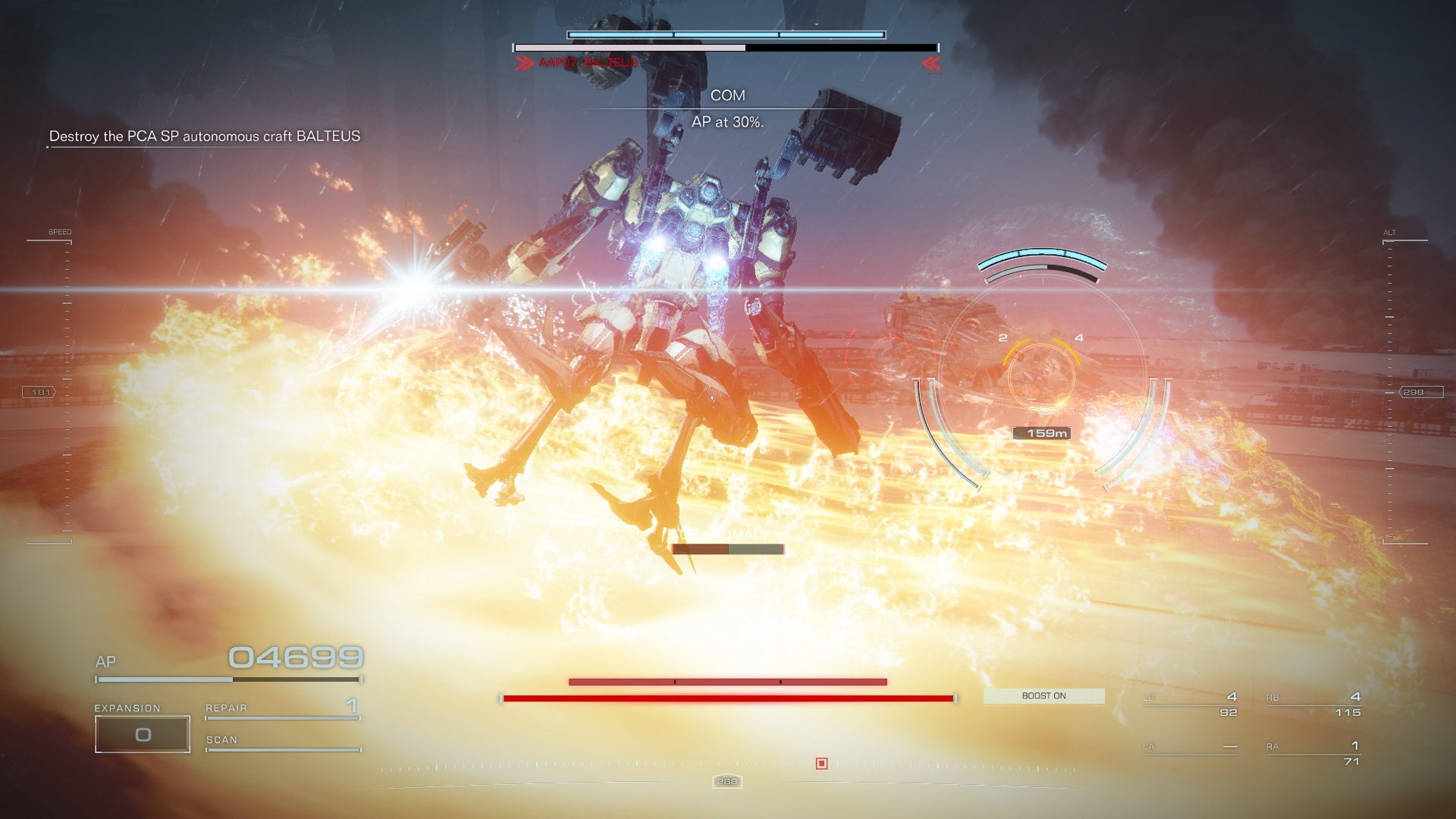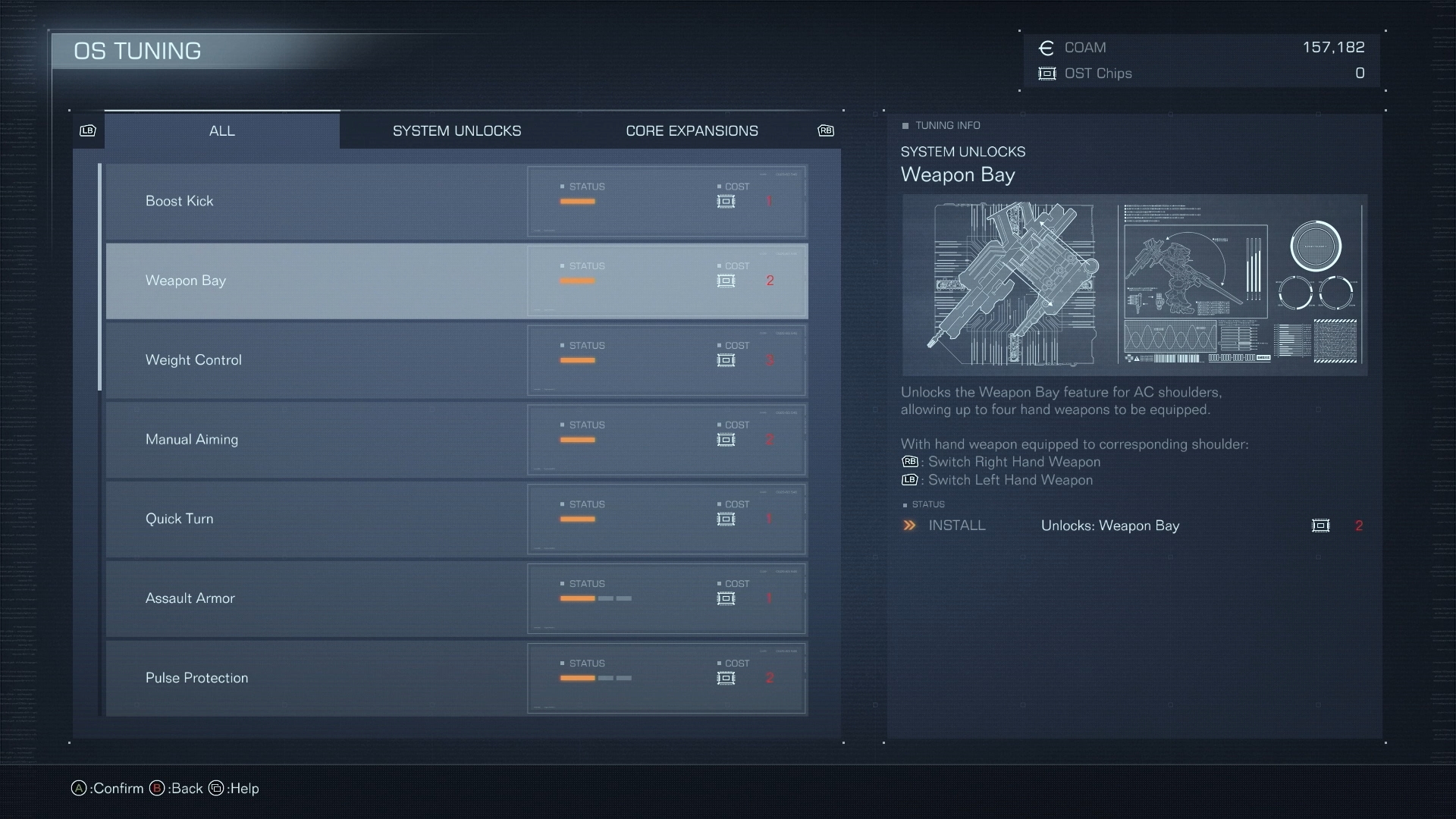
It famously took the breakout success of Dark Souls, and a player petition, to get FromSoftware to start bringing its games to PC. Until 2011 nearly everything the Japanese developer made was exclusive to consoles, including 15 mech combat games in the Armored Core series. Alongside MechWarrior, Armored Core could've been huge on PC in the late '90s and early 2000s, serving as a more actiony, less simmy companion.
Well, that didn't happen. But 25 years later, there's finally an Armored Core on PC. I've played about five hours of it, and I'm here to tell you this game fucking RIPS.
Armored Core 6 is exactly what I hoped it would be. Incredibly fast-paced. Empowering. It puts you in a mech that can fly and dash in all directions, with a depth of customization that has me greedy to unlock every part and spec out a livery of different purpose-built machines. The controls demand fast reflexes but are mercifully pretty simple, even with all your weaponry and mobility.
This sci-fi future is just grimy and mean, casting your pilot as the pawn of uncaring corporations all pettily vying for power. The density of the environments can sometimes be breathtaking, colossal factories and latticeworks of enormous girders swallowing the horizon, but the dialogue is constantly reminding you that you're just there to labor for someone else. That nail-biting victory against an army of inferior mechs that made you feel like hot shit just moments ago? That was really just a line on a spreadsheet for one of these monolithic corporations; you'll be lucky to get a thank you.
Basically, what I'm saying is this is quintessential Armored Core—even in some ways that I think longtime fans of the series have been worried about.
And that's kind of a big deal. As much as FromSoftware has been saying "We're making an Armored Core game," the follow-up question from just about everyone has been "Soooo… how much Dark Souls is in there?"
From the five hours I've played, the answer is "almost none," at least not in ways that change the core (sorry) experience. This is AC6's great strength. It's a reminder that FromSoftware's developers can make different kinds of games—that their knack for action, for over-the-top bosses, for settings that get under your skin, didn't start and end with the Souls games. As a follow-up to Elden Ring, Armored Core 6 is also a welcome palate cleanser: Instead of boundless exploring, here you've got a mission to complete, someone or something to blow up, and you'll probably be done or dead in about five minutes.
That's one of the things I'm talking about when I say this is quintessential Armored Core.
Armored Core 6's missions

When I got to see a hands-off preview of AC6 a couple months ago, I got the impression that missions in this game were much longer than what I was used to in the PS2-era Armored Core 3, where I could finish a lot of missions in under five minutes. That hands-off preview was from chapter two of this game, so maybe missions are going to get a bit longer and more involved after the first chapter that I've now played myself. But I think I overestimated how long the average mission is going to be based on that early look. Based on chapter one, I'd say most of the missions in AC6 will have you in and out in under 10 minutes. Fifteen, tops. On repeat playthroughs of some of the chapter one missions after I'd upgraded my mech, I was breezing through them in just four or five minutes.
That pacing feels right for Armored Core, because there is not much opportunity for downtime. Within seconds you'll be dodging tons of incoming fire, managing your boost meter, and staying on top of all your weapon cooldowns. It's exhilarating, but definitely best in short bursts.
This compact mission-based design is a really different experience than the long treks through areas in the Souls games, but each approach suits its setting well. In Armored Core you're a mercenary in an incredibly powerful machine—you get in and get it done. The Souls games are about being an adventurer, lost and inquisitive, surviving a long, arduous quest.
The lock-on system

I've seen some longtime Armored Core fans express a worry about the "hard lock" in Armored Core 6, which works the way lock-on does in many 3D games: it directs your attacks at the target and also keeps them framed with your camera. The older Armored Core games didn't work that way at all. A component of your mech effectively controlled how big your targeting reticle was, and you had to keep them within that reticle to have your attacks automatically aim at the closest target, but the camera control was all on you.
Armored Core 6 mixes the old and the new here. When you get close enough to an enemy your weapons will still automatically lock onto them, and you'll still be fully in control of your camera. AC6 also still has an upgradeable mech part that affects your accuracy, with separate specs for close, medium, and long-range assist.
It does add a new "hard" lock option called Target Assist that's comparable to the Souls games (and most other 3D games, for that matter). Target Assist keeps the camera centered on a single enemy for you. This addition feels like a must to me because of the speed Armored Core 6 moves at, and in practice I don't think longtime fans are going to be too upset about it, because Target Assist actually comes with a distinct tradeoff.
Here's what the tutorial text in the first level says, verbatim: "When enabled, Target Assist will automatically orient the camera and your AC toward the current target. However, this comes at the cost of reduced aiming precision. Consider the situation and your level of skill when choosing whether to enable this feature."
I noticed the difference as soon as I went up against tougher enemies. I'd hard-lock onto highly mobile enemy ACs and watch my missiles splash harmlessly on either side of them as they dodged around. As in classic Armored Core, there's definitely still going to be an art to keeping an enemy in your sights to accurately land your shots.
OS Tuning

AC6 brings back the arena, a companion to the campaign where you have 1v1 battles against NPC mechs. One of the rewards for winning in the arena ties into a level of customization that goes beyond swapping parts in and out of your mech, called OS Tuning. You won't unlock it until a few hours into the campaign, but this system lets you spend a resource to unlock some more meta upgrades for your mechs, some of which hearken back to older games in the series. There's one called Weapon Bay, which lets you give up your back weapons (where stuff like missile launchers usually live) for two extra hand weapons (rifles, machine guns, energy blades) that you can swap between with a controller's shoulder buttons. While it's not quite the same thing, this brought to mind Armored Core 4's weapon system for me. In that game, you'd swap between firing your back and hand weapons with the same shoulder buttons.
There's also an OS Tuning unlock called Manual Aiming to independently control your firing reticle, and a quick turn option that lets you perform snap 90 degree turns, an upgrade I found invaluable in the much, much slower-moving Armored Core 3. So even with the addition of the "hard lock" Target Assist, FromSoftware clearly felt that quick turn was still an important option in AC6.
Stagger
View post on imgur.com"
In AC6, repeatedly hitting enemy mechs will build up a stagger meter that eventually stuns them and exposes them to extra damage. I think a few folks worried about the Soulsification of Armored Core saw this as a system pulled wholesale from Sekiro: Shadows Die Twice (that game's lead designer is now directing Armored Core 6). But stagger works really well with Armored Core's open-ended sandbox.
Different types of weapons deal more and less stagger damage and more or less damage to staggered enemies, and the way you stagger enemies honestly strikes me as a clearer, more strategic implementation of getting stunned by heavy weapon hits, which would happen in older AC games.
Unless something goes really wrong after the first chapter, Armored Core 6 is a dream mech game for me. It's fast and demanding, but offers so much freedom to customize your mech. It frames its challenge around getting through short, intensive encounters rather than long slogs.
By the end of my demo session I was replaying missions with different builds just to see if I could do them better and faster; I really can't wait to sink my teeth into the full game on August 25 and see the entire arsenal of mecha parts at my disposal.







